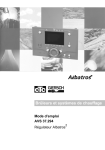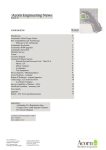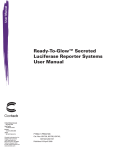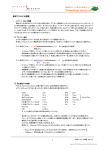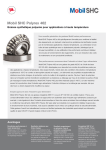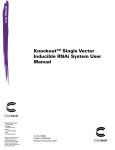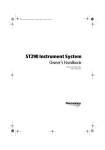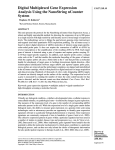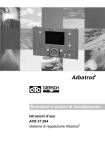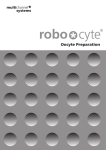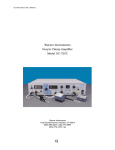Download RNA Isolation from Xenopus - Cell Decision Process Center
Transcript
Chapter 1 RNA Isolation from Xenopus Inner Ear Sensory Endorgans for Transcriptional Profiling and Molecular Cloning Casilda Trujillo-Provencio, TuShun R. Powers, David R. Sultemeier, and Elba E. Serrano Abstract The amphibian Xenopus offers a unique model system for uncovering the genetic basis of auditory and vestibular function in an organism that is well-suited for experimental manipulation during animal development. However, many procedures for analyzing gene expression in the peripheral auditory and vestibular systems mandate the ability to isolate intact RNA from inner ear tissue. Methods presented here facilitate preparation of high quality inner ear RNA from larval and post-metamorphic Xenopus specimens that can be used for a variety of purposes. We demonstrate that RNA isolated with these protocols is suitable for microarray analysis of inner ear organs, and for cloning of large transcripts, such as those for ion channels. Genetic sequences cloned with these procedures can be used for transient transfection of Xenopus kidney cell lines with GFP fusion constructs. Key words: RNA, auditory, vestibular, Xenopus laevis, Xenopus tropicalis, microarray, cloning, transcriptional profiling, heterologous gene expression. 1. Introduction Xenopus laevis (X. laevis) is a widely used and well-established organism that has contributed to our understanding of embryogenesis and cellular development for well over 50 years (1). In large part, X. laevis is a popular experimental species because the stages of X. laevis development have been richly detailed from the fertilized egg to the mature adult, and because the organism is extremely easy to breed and maintain in the laboratory (2). However, the relatively long generation time (∼18 months) and allotetraploid genome have been an impediment to genetic Bernd Sokolowski (ed.), Auditory and Vestibular Research: Methods and Protocols, vol. 493 C 2009 Humana Press, a part of Springer Science+Business Media DOI 10.1007/978-1-59745-523-7 1 Springerprotocols.com 3 4 Trujillo-Provencio et al. studies with this species. In recent years, Xenopus tropicalis (X. tropicalis) has emerged as another member of the genus Xenopus that is a superior alternative for molecular genetic analysis and large scale sequencing efforts due to its diploid genome and shorter (∼5 months) generation time (3, 4). Using X. laevis and X. tropicalis as our experimental systems, we aim to understand the developmental mechanisms that give rise to the uniquely-shaped auditory and vestibular endorgans of the inner ear with their characteristically patterned epithelia comprised of specialized mechanosensory hair cells (5–7). We are especially interested in the specification of the electrical phenotype of hair cells and in determining the cadre of ion channels that typify endorgans of the inner ear (8–10). Our target for molecular investigations is the inner ear of both Xenopus species. However, the diminutive inner ears that reside in the Xenopus otic capsule provide limited amounts of tissue for RNA isolation. This restriction has posed an additional challenge for the identification of genes that are expressed in the inner ear (6, 9). The protocols that we have developed and that are presented here permit isolation of high quality RNA from larval and postmetamorphic Xenopus inner ears of both species. Furthermore, methods that are applicable for RNA isolation from the Xenopus inner ear have been validated as suitable for RNA isolation from other Xenopus organs such as brain and kidney, as well as Xenopus cell lines. Since the inner ear originates from a neurogenic placode (11), many genes expressed in the inner ear are also expressed in nervous tissue. Inner ears also share common sensitivities with kidneys to antibiotics and other drugs (12). Therefore, these RNA isolation protocols can be used to design experiments that identify genes expressed during development of various Xenopus organs, and in the response of organs and cell lines to chemical challenges. The total RNA isolated with our procedures was used in two downstream applications, transcriptional profiling (13) and molecular cloning (9). Ion channel genes cloned with these methods can be fused to sequences for a fluorescent reporter molecule such as green fluorescent protein (GFP) and expressed in Xenopus kidney cell lines using lipid-mediated transient transfection protocols (14). 2. Materials 2.1. Tissue Preparation 1. Xenopus laevis and Xenopus tropicalis are obtained from Nasco (Fort Atkinson, WI). X. laevis larvae are purchased as a unit of Stage 48–55 tadpoles (cat. no. LM00450MX) and maintained in aquaria until they reach developmental Stage 55–56. Juvenile animals (X. laevis, cat. no. LM00453MX and X. tropicalis, cat. no. LM00821MX) are used within a week RNA Isolation from Xenopus Inner Ear 2. 3. 4. 5. 6. 7. 5 of arrival. All procedures involving animals are approved by the New Mexico State University Institutional Animal Care and Use Committee. Ethyl 3-aminobenzoate methanesulfonate salt: Prepare a 2% (w/v) stock solution in water (see Notes 1 and 2). Store the stock solution at 4 ◦ C and discard after one month. Working solutions of 0.2% (larvae) and 0.5% (juvenile animals) are prepared the day of use by diluting the stock solution with 0.01 M phosphate buffered saline: 1. 5 mM KH2 PO4 , 8. 1 mM Na2 HPO4 , 138 mM NaCl, 2. 7 mM KCl, pH 7.4 (PBS, cat. no. P3813, Sigma-Aldrich, St. Louis, MO). Water treated with 0.1% (v/v) diethyl pyrocarbonate (DEPC, cat. no. D5758, Sigma-Aldrich) (see Notes 1 and 3). R R RNaseZap and RNAlater (Ambion, Austin, TX). Dissecting tools: Dumont #5 forceps, standard straight fine Iris scissors, scalpel handle #3 (all from Fine Sciences Tools, Foster City, CA); BD Bard-Parker Sterile Scalpel Blades #11 (VWR, West Chester, PA); 60 × 15 mm glass Petri dish (VWR) filled with black wax (Nasco, Fort Atkinson, WI). Olympus SZ61 dissecting stereomicroscope (Leeds Precision Instruments, Minneapolis, MN). Microcentrifuge tubes sterilized by autoclaving, 1.7 mL and 2.0 mL; and 22 gauge needles (VWR). R RNeasy Mini Kit (Qiagen, Valencia, CA). 14. 3 M β-mercaptoethanol. R Kimwipes (VWR). Brinkmann Polytron PT1200 handheld homogenizer with sawtooth 0.5 mm generator (VWR). 2.2. Total RNA Isolation 1. 2. 3. 4. 2.3. Total RNA Clean-up 1. The DNA-freeTM kit, 5 M ammonium acetate, 5 mg/mL linear acrylamide, and THE RNA Storage Solution (all from Ambion, Austin, TX). 2. 100% ethanol (Aaper Alcohol, Shelbyville, KY). 3. 70% ethanol is prepared by diluting 100% ethanol with DEPC-treated water. 4. Refrigerated centrifuge (e.g., Beckman Coulter AllegraTM 21R Refrigerated Centrifuge; VWR). 2.4. Determination of Total RNA Quality and Quantity 1. Agilent 2100 Bioanalyzer and Agilent RNA 6000 Nano Kit (Agilent Technologies, Palo Alto, CA). 2.5. Microarray Analysis R R 1. GeneChip Xenopus laevis Genome Array and GeneChip One-Cycle Target Labeling Kit (Affymetrix, Santa Clara, CA). 6 Trujillo-Provencio et al. 2. gcRMA (Robust multichip averaging) summarization method downloaded from bioconducter.org and executed in the R package (http://www.r-project.org/). R R 3. Spotfire DecisionSite 9.0 for Functional Genomics (Spotfire, Inc., Somerville, MA). 2.6. Molecular Cloning of Genes Identified with Transcriptional Profiling 1. SMARTTM RACE cDNA Amplification Kit (Clontech Laboratories, Inc., Mountain View, CA). R 2. PicoMaxx High Fidelity PCR System (Stratagene, La Jolla, CA). 3. Thermal cycler (e.g., TC-512, Techne Inc., Burlington, NJ). 4. Lyophilized gene specific primers, 10 nmole (Operon, Huntsville, AL). R 5. SeaKem LE Agarose (Cambrex Bio Science Rockland, Inc., Rockland, ME). 6. Tris-acetate/EDTA electrophoresis buffer (TAE 1X): 0.04 M Tris base, 0.001 M EDTA, 1.0 M glacial acetic acid. A 50X stock solution is prepared in a glass bottle and stored at room temperature (22–26 ◦ C). 7. Agarose gel with ethidium bromide: Prepare by diluting 10 mg/mL ethidium bromide stock solution (cat. no. E1510, Sigma-Aldrich) to a final concentration of 0. 25 μg/mL in melted agarose gel. Do not include ethidium bromide in the running buffer. 8. 1 kb DNA ladder (New England Biolabs, Inc., Ipswich, MA). R 9. S.N.A.P.TM UV-Free Gel Purification Kit and TOPO XL R PCR Cloning Kit with One Shot TOP10 ElectrocompTM E. coli (Invitrogen, Carlsbad, CA). 10. Lambda Bio UV/Vis Spectrometer (Perkin Elmer Corp., Norwalk, CT). 11. Electroporator 2510 and electroporation cuvettes (Eppendorf, Westbury, NY). R 12. BigDye Terminator v3.1 Cycle Sequencing Kit (Applied Biosystems, Foster City, CA). R 13. ABI PRISM 3100 Genetic Analyzer (Applied Biosystems). 2.7. Heterologous Inner Ear Gene Expression 1. pAcGFP1-C1 expression vector (Clontech Laboratories, Inc.). 2. XbaI and SpeI restriction enzymes; Antarctic phosphatase; and Quick LigationTM Kit (all from New England Biolabs). 3. X. laevis A6 kidney cell line (American Type Culture Collection, Manassas, VA). 4. Cell culture medium per 100 mL: 75 mL of NCTC-109 (cat. no. N1140, Sigma-Aldrich), 10 mL Newborn Calf Serum (cat. no. N4637, Sigma-Aldrich), 2 mL of 200 mM L-glutamine (cat. no. G7513, Sigma-Aldrich), and 13 mL of Milli-Q water. Combine medium components, then filter sterilize with a 250 mL StericupTM -GP Filter Unit (Millipore Cor- RNA Isolation from Xenopus Inner Ear 7 poration, Billerica, MA). Passage reagent: Filter sterilized 0.25% Trypsin-EDTA (cat. no. T4049, Sigma-Aldrich). Store aliquots consisting of 10 mL of Newborn Calf Serum, 2 mL of L-glutamine, and 10 mL of 0.25% Trypsin-EDTA at −20 ◦ C. R 5. Labconco PurifierTM Class II Safety Cabinet and VWR Water Jacketed CO2 Incubator Model 2310 (VWR). 6. BD Falcon culture slides, two- or four-chamber (cat. no. 53106-302 or 53106-304, VWR). 7. LipofectamineTM 2000 Transfection Reagent (cat. no. 11668027, Invitrogen). 2.8. Epifluorescence Imaging 1. 3.7% paraformaldehyde is prepared by diluting 10% paraformaldehyde in PBS. The paraformaldehyde should be prepared fresh for each experiment. 2. Hoechst 33342, 10 mg/mL. R 3. SlowFade Antifade Kit (Invitrogen). R 4. VWR micro cover glasses No.1, 24 × 50 mm. 5. Clear fingernail polish. 6. CoolSNAPTM HQ CCD camera (Photometrics, Tucson, AZ). 7. Nikon TE2000 epifluorescence microscope equipped with a UV-2A filter cube (UV excitation) and a B-2E/C filter cube (Blue excitation) (A.G. Heinze Inc., Lake Forest, CA). R 8. MetaVueTM Imaging System Version 6.0r5 and MetaMorph Offline Imaging System Version 6.0r5 (Molecular Devices Corporation, Sunnyvale, CA). R R 9. Adobe Photoshop Version 7.0.1 (Adobe Systems Incorporated, San Jose, CA). 3. Methods Many methods requiring total RNA as a starting material are significantly affected by the quality of the RNA isolated from the tissue of interest. Furthermore, when tissue is limited, the success of methods that dictate a specific amount of starting RNA is hindered because the amount of total RNA that can be retrieved is diminished. Isolation of total RNA from the minuscule inner ear of Xenopus (5, 7), for molecular pursuits such as transcriptional profiling and molecular cloning, presents such a challenge. In addition, the total RNA must be of very high quality, with a demonstrable lack of degradation and the presence of transcripts greater than 3 kb. After numerous attempts to isolate a sufficient amount of high quality total RNA from the inner ear of Xenopus, we were able to optimize the method by working quickly through tissue dissections, meticulously cleaning the tools used in the procedure 8 Trujillo-Provencio et al. R R with RNaseZap , bathing the exposed tissue with RNAlater , R and incorporating the use of the Qiagen RNeasy Mini Kit. Additionally, the use of the Agilent 2100 Bioanalyzer for RNA characterization greatly enhanced our capacity to detect and analyze isolated total RNA and to standardize protocols (see Fig. 1.2). Previously, the use of denaturing gel electrophoresis and a spectrophotometer was standard for assessing the quality and quantity of RNA. This procedure resulted in the loss of μg amounts of total RNA. In contrast, the Agilent 2100 Bioanalyzer can detect and assess the quantity of as little as 25 ng/μL total RNA and the quality of as little as 5 ng/μL total RNA (15). The Bioanalyzer characterizes the sample with an RNA integrity number (RIN) that can be used to establish a quantitative standard for RNA quality for each application. We consider this type of equipment and quantitative analysis a major contributor to the success and replicability of our methods, especially for transcriptional profiling. High quality RNA enhances the success of RT-PCR Rapid Amplification of cDNA Ends (RACE) reactions, especially when long transcripts are sought. With our protocols, we typically visualize one sharp band of a PCR product when gene specific R primers and the PicoMaxx High Fidelity PCR system are used R to amplify a gene of interest (see Fig. 1.3C). The PicoMaxx High Fidelity PCR system uses a blend of Taq and Pfu DNA polyR polymerase-enhancing merases and an exclusive ArchaeMaxx factor. The system provides high PCR sensitivity and fidelity which facilitates the detection and amplification of low copy number targets up to 10 kb in size. For example, we routinely obtain R target PCR products in the 3–4 kb range (9). Using the TOPO R XL PCR Cloning Kit in conjunction with the PicoMaxx High Fidelity PCR system enabled the cloning of transcripts greater than 3 kb. It is crucial to confirm that clones are full length and of the expected identity by sequencing prior to other downstream applications such as heterologous expression in a cell culture system (see Fig. 1.3D). We enlisted the transcriptional profiling approach, using microarray analysis, in order to better understand global gene expression patterns that underlie X. laevis inner ear function (see Fig. 1.3A). Using microarray methods, we identified several R genes on the GeneChip X. laevis genome array that are differentially expressed in X. laevis inner ear as compared with brain (13). For example, we detected a gene which has been implicated in hereditary deafness, the gap junction protein β2 (GJB2) (16), during analysis of our microarray data. The difference in GJB2 expression levels in X. laevis inner ear was nearly 4X that of the brain (see Fig. 1.3B). The relative GJB2 abundances detected through microarray analysis of inner ear and brain RNA are also apparent when inner ear and brain RNA are used as template in RNA Isolation from Xenopus Inner Ear 9 RT-PCR RACE reactions with GJB2 gene specific primers (see Fig. 1.3C). Thus, RT-PCR RACE reactions replicate the gene’s transcriptional profile between organs as detected with microarrays. We interpret these findings as an indication of the indispensable contribution of high quality RNA to the consistency between replicates and the identification of inner ear specific genes. In summary, we recommend: • Work quickly and follow established best practices for handling RNA (17) R • Clean tools with RNaseZap • Bathe tissue with RNAlater R during surgery R • Use Qiagen RNeasy Mini Kit • High quality RNA (RIN>8) is essential; use the Agilent Bioanalyzer or similar equipment to assess RNA quality • At least 1 μg of high quality RNA (RIN>8) is optimal • Use total RNA within 72 h for microarray experiments • 18–20 μg of biotin-labeled cRNA are required before proceeding to the fragmentation and hybridization steps • Review electropherograms for size distributions of cRNA/ mRNA samples; transcripts greater than 3 kb should be present in the sample, especially if ion channels and other membrane transporters and receptors are target genes R • Use the PicoMaxx High Fidelity PCR System or equivalent R • Use the TOPO XL PCR Cloning Kit or equivalent As per standard laboratory procedures, investigators are reminded that they should review chemical MSDS sheets prior to use and ensure that reagents are handled and discarded in compliance with all federal and state regulations. Protocols that use animals in research must be approved by the Institutional Animal Care and Use Committee prior to initiating experiments. Recommended guidelines for the use of Xenopus in research are available online (18–20). 3.1. Tissue Preparation 1. Take precautions to eliminate sources of RNase contamination by following rigorous laboratory procedures for working with RNA. Minimal practices include a clean bench, strict adherence to the use of gloves throughout the procedure, a dedicated set of pipettors, and disposable sterile plasticware. Prior to dissections, clean all dissection tools and the Polytron R generator with RNaseZap and rinse thoroughly with DEPCtreated water (see Note 4). 2. Partially immerse stage 55–56 larvae and juvenile (2.5–3.5 cm, 1.0–3.0 g) X. laevis or juvenile X. tropicalis (1.5–2.5 cm, 0.8–2.0 g) in a solution of ethyl 3-aminobenzoate methanesulfonate salt (0.2% for Stage 55–56 larvae and 0.5% for juveniles) for 10–30 min at room temperature (22–26 ◦ C). The solution should cover the torso of the animal but leave the nostrils of the animal exposed to air. 10 Trujillo-Provencio et al. 3. Work quickly during the dissections to minimize tissue exposure to RNases. Pierce larval hearts and decapitate juvenile animals prior to aseptic removal of inner ear tissue. Also, extract brain and kidney tissue from juvenile animals. 4. Use a dissecting stereomicroscope (e.g., Olympus SZ61) for the dissection of tissues. 5. Remove larval inner ears by approaching the tissue from the dorsal side of the animal (see Fig. 1.1A). Peel the skin away from the area above the brain and otic capsules and remove the soft bone of the skull and otic capsules, using a surgical scalpel and fine forceps. Once the tissue is exposed (see R Fig. 1.1B), bathe it with RNAlater to prevent degradation of RNA. Extract the inner ear by grasping the eighth cranial nerve and withdrawing the nerve and its target sensory organs from the otic capsule. 6. Remove juvenile inner ears and brains by approaching the tissue ventrally from the roof of the mouth after removing the lower jaw. To facilitate the dissection, pin the top of the head and the exposed spinal cord to the dissecting dish with 22 gauge needles. Despite the animal size difference, X. tropicalis inner ears are only slightly smaller than those of X. laevis, and overall the inner ears of the two species are of comparable dimensions (see Fig. 1.1C,D). Remove the skull and otic capsule bone with a surgical scalpel and fine forceps. Bathe R the exposed tissue (see Fig. 1.1D) copiously with RNAlater . Then, extract the inner ear tissue as described in the larval Fig. 1.1. Xenopus inner ear and brain dissections. (A) Dorsal view of X. laevis Stage 56 larva prior to dissection. (B) Dorsal view of exposed X. laevis Stage 56 inner ear (E) and brain (Br) after the tissue and bone are removed. (C) Ventral view of X. laevis juvenile upper jaw prior to dissection. (D) Ventral view of exposed X. tropicalis juvenile inner ear (E) and brain (Br) after tissue and bone are removed. Arrows point to the 8th cranial nerve (N). Anterior (top), Posterior (bottom). Scale bar = 1 mm. RNA Isolation from Xenopus Inner Ear 11 preparation. After removal of inner ear tissue, sever the brain from all nerve branches and carefully remove with fine forceps. 7. The dissected tissue is placed in a 2.0 mL microcentrifuge R tube, containing 200–400 μL of RNAlater , immediately after removal from the animal. 8. Use tissue immediately for RNA isolation or store at −20 ◦ C for several months or at −80 ◦ C indefinitely prior to RNA isolation. 3.2. Total RNA Isolation 3.3. Total RNA Clean-up R 1. Use the RNeasy Mini Kit from Qiagen for total RNA isolation. R , blot quickly 2. Remove the dissected tissue from the RNAlater R on a Kimwipe (from a clean box reserved for RNA work), and immediately place in a pre-weighed 2.0 mL microcentrifuge tube containing 600 μL of Buffer RLT and 6 μL of 14. 3 M β-mercaptoethanol. 3. Determine the tissue weight by subtracting the weight of the tube plus Buffer RLT and β-mercaptoethanol from the weight of tube containing the tissue plus Buffer RLT and β-mercaptoethanol. 4. Extract no more than 30 mg of tissue, as recommended by the vendor, for each total RNA isolation (see Note 5). 5. Disrupt the tissue using a homogenizer such as a Brinkman Polytron with a 0.5 mm generator set at the highest setting. Pulse samples 3–5 times for ∼5–10 s until the tissue is completely homogenized and the solution is uniform in texture and color. Cool the tube on ice between pulses. 6. After the tissue is uniformly homogenized, follow the R RNeasy Mini Kit protocol as described in the manual. 7. Elute total RNA in two steps, first with 50 μL and then with 40 μL of RNase-free water provided with the kit. 1. Use the DNA-freeTM kit from Ambion to purify total RNA sample. 2. Treat the total RNA obtained from step 7, Section 3.2 with DNaseI to degrade any DNA in the sample. Follow the protocol manual with a DNaseI incubation time of 30 min. 3. Following the DNase inactivation step, transfer the total RNA solution to a clean 1.7 mL microcentrifuge tube and precipitate by adding 0.1X volume of 5 M ammonium acetate, 0.015X volume of 5 mg/mL linear acrylamide, and 2X volume of 100% ethanol. 4. Incubate the total RNA precipitation reaction overnight at −20 ◦ C. 5. Recover the total RNA pellet by centrifugation at 10,000 g for 20 min at 4 ◦ C. Discard the supernatant, and wash the pellet with 300 μL of 70% ethanol. Repeat centrifugation for 10 min. 12 Trujillo-Provencio et al. 6. Discard the wash supernatant, and air dry the pellet at room temperature for 15 min. 7. Resuspend total RNA in 8–15 μL of THE RNA Storage Solution and incubate in a 37 ◦ C water bath for 5 min. 8. Store the sample at −80 ◦ C or place on ice and analyze for quality and recovery. 3.4. Determination of Total RNA Quality and Quantity 1. Dilute the total RNA sample 1:3 in THE RNA Storage Solution and use the Agilent RNA 6000 Nano Kit to prepare the RNA for the determination of quality and quantity. 2. Follow the vendor’s instructions of the Agilent 2100 Bioanalyzer to generate an electropherogram and an RNA Integrity Number (RIN) for each RNA sample. An electropherogram displaying two well-defined peaks of 1.8 kb (18S rRNA) and 4.0 kb (28S rRNA) and a RIN above 8 are indicative of high quality RNA (see Fig. 1.2B1). For typical yields of total RNA isolated from Xenopus tissues see Note 6. Figure 1.2 shows representative electropherograms generated by the 2100 expert software. 3.5. Microarray Analysis 1. Use total RNA, obtained in Section 3.3, step 8, from juvenile and larval X. laevis in microarray experiments within 72 h of tissue dissection. At least 1 μg (5–10 μL) of high quality RNA with a RIN above 8 is required for cRNA synthesis (see Note 7). 2. Prepare biotin-labeled cRNA for hybridization to the R GeneChip Xenopus laevis Genome Array by using the GeneChip R One-Cycle Target Labeling kit, following the vendor’s instructions. 3. Determine the amount of biotin-labeled cRNA by analyzing diluted cRNA (1:10 or 1:20) on the Agilent 2100 Bioanalyzer in order to ensure that 18–20 μg of biotin-labeled cRNA are available for the fragmentation and hybridization steps (see Note 8). Review electropherograms, generated by using the 2100 expert software from Agilent, to evaluate the size distributions of the cRNA samples to be used for transcriptional profiling. For inner ear and brain, expect the sample to contain cRNA that is greater than 3 kb. (see Fig. 1.2C for a cRNA sample prepared by the BioMicro Center at the Massachusetts Institute of Technology, Cambridge, MA, using the aforementioned technology). 4. After image acquisition, normalize the raw data using the gcRMA (Robust multichip averaging) summarization method. After normalization, analyze all microarray data using R R the Spotfire DecisionSite 9.0 for Functional Genomics software. A heat map that graphically represents the levels of gene expression from one array of X. laevis inner ear tissue is shown in Fig. 1.3A. RNA Isolation from Xenopus Inner Ear 13 Fig. 1.2. X. laevis inner ear total RNA and cRNA evaluated with an Aligent 2100 Bioanalyzer. (A1) Electropherogram of degraded total RNA. This electropherogram is typical of RNA isolated from X. laevis juvenile inner ear tissue prior to R Mini Kit. The RNA sample had a low (5.2) RNA Integrity Number (RIN). (A2) implementation of the Qiagen RNeasy Gel representation of total RNA shown in A1. (B1) Electropherogram of high quality (non-degraded) total RNA. This R electropherogram is typical of RNA extracted from X. laevis Stage 56 larvae inner ear tissue with the Qiagen RNeasy Mini Kit using the procedures described in Sections 3.2–3.4. The RNA sample had a high (9.0) RNA Integrity Number (RIN). (B2) Gel representation of total RNA shown in B1. (C) Electropherogram of biotin-labeled cRNA synthesized from the total RNA shown in B1. The cRNA of inner ear samples typically includes sequences greater than 3000 nt. Axis units: Abscissa A1 and B1, migration time (seconds, s); Abscissa C, nucleotides (nt); Ordinate, fluorescence units (FU). 14 Trujillo-Provencio et al. Fig. 1.3. Applications of RNA for transcriptional profiling (A, B), molecular cloning (C), and heterologous gene expression in cell culture (D). (A) Heat map of inner ear microarray data. X. laevis juvenile inner ear total RNA ( ∼ 1 μg) was R R Xenopus laevis Genome Array. The heat map was constructed using Spotfire labeled and hybridized to the GeneChip R DecisionSite 9.0 software. The data are organized numerically by probe set ID with the lowest ID number at the top. In this sample, the normalized intensity values (log base 2) for the 15,491 probe sets ranged from 0.8 (low) to 15.22 (high). The intensity color code for expression: L – low, M –intermediate, H – high. (B) Microarray detection of the expression of the gap junction protein beta 2 (GJB2) in inner ear and brain. The average and standard deviation values in the histograms were calculated from three different microarray experiments. Low standard deviations characterized the sample replication. (C) RT-PCR RACE detection of GJB2 transcript in X. laevis juvenile inner ear and brain. Lane 1 – inner ear, minus RT control, GJB2 primer pair 1; Lane 2 – brain, minus RT control, GJB2 primer pair 1; Lane 3 – PCR reaction control, minus cDNA template, GJB2 primer pair 1; Lane 4 – inner ear, GJB2 primer pair 1; Lane 5 – brain, GJB2 primer pair 1; Lane 6 – inner ear, GJB2 primer pair 2; Lane 7 – brain, GJB2 primer pair 2. Lane L − 5 μL of NEB 1 kb DNA ladder. cDNA is detected in lanes 4–7. Expression levels correlate with the microarray data shown in B. (D) GFP-positive Xenopus A6 kidney cells transfected with the GFP-BK clone. Dashed lines encircle transfected A6 cells (GFP) and dotted lines encircle stained nuclei (Hoechst). Scale bar = 50 μm. RNA Isolation from Xenopus Inner Ear 3.6. Molecular Cloning of Genes Identified with Transcriptional Profiling 15 1. The expression of genes detected with microarray analysis can be confirmed with molecular cloning using RT-PCR RACE protocols. 2. Use X. laevis and X. tropicalis inner ear or brain total RNA, acquired in Section 3.3, step 8, as a template for RT synthesis of first strand cDNA. Prepare 5 -RACE-Ready first strand cDNA in separate reactions, according to the instruction manual of the SMARTTM RACE cDNA Amplification Kit, using 1 μg of control RNA from the kit and 1 μg of the following experimental samples: X. laevis inner ear or brain total RNA, X. tropicalis inner ear or brain total RNA. 3. Run control PCR reactions that amplify the first strand cDNA, prepared from the kit RNA according to the vendor’s protocols, to evaluate the success of the 5 RACE reactions. Analyze control PCR products by agarose gel electrophoresis, as described in the kit manual, before proceeding with the experimental PCR reactions with Xenopus samples. If the expected products are observed, use the Xenopus first strand cDNA samples for PCR reactions. If products are not detected, the first strand synthesis reactions must be repeated following recommendations outlined in the troubleshooting section of the user manual. 4. Use the 5 -RACE-Ready inner ear or brain first strand cDNA samples (5–10 μL in a 50 μL reaction volume) to amplify secR ond strand cDNA according to the PicoMaxx High Fidelity PCR System user manual. The thermal cycler parameters are as follows: initial denaturation, 95 ◦ C for 2 min; 35 cycles of 95 ◦ C for 40 s, Tm minus 3 ◦ C for 30 s, 72 ◦ C for 3 min; final extension 72 ◦ C for 10 min. Design gene specific primers to the gene of interest and obtain from Operon (Huntsville, AL). The primer Tm’s are specified in the Oligonucleotide Data Sheet provided by Operon and vary by primer pair. 5. Analyze 7 μL of the PCR reaction on a 1.2% agarose gel (0. 25 μg/mL ethidium bromide) in 1X TAE buffer. 6. Isolate the resultant PCR fragments using the S.N.A.P.TM UV-Free Gel Purification Kit, according to the vendor’s instructions, until the quantification step. For quantification, analyze 10 μL of the isolated fragment on a Lambda Bio UV/Vis Spectrometer. R 7. Clone the purified PCR product using the TOPO XL PCR R Cloning Kit with One Shot TOP10 ElectrocompTM E. coli, according to the kit manual with a 3:1 molar ratio of insert to vector. After the ligation step, use the Electroporator 2510 to transform the electrocompetent cells with a setting of 1400 V. 8. Analyze between 5–10 positive clones by restriction enzyme digestion to confirm the presence of an insert. Sequence 16 Trujillo-Provencio et al. 9. 10. 11. 12. 13. 14. R clones with inserts following the BigDye Terminator v3.1 Cycle Sequencing Kit protocol and analyze sequencing reacR tions using the ABI PRISM 3100 Genetic Analyzer. Molecular cloning, using the RT-PCR RACE procedures described above, can be used to confirm the differential expression of genes such as the X. laevis EST, GenBank Accession no. BJ076720 (National Institute for Basic Biology Mochii normalized Xenopus tailbud library, Clone ID# XL058il6 (3 )). This gene is detected with Affymetrix (Santa R Clara, CA) probe set Xl.8924.1.A1 at using the GeneChip Xenopus laevis Genome Array. The Affymetrix annotation states that this probe set targets X. laevis connexin 29 (gap junction protein β2, GJB2). Microarray analysis suggests that this gene is expressed at higher levels in the inner ear than in the brain (see Fig. 1.3B). Design primers to amplify two regions within the 3,292 bp Affymetrix consensus sequence for the Xl.8924.1.A1 at probe set. Use the HMMgene v. 1.1 program (21) to determine the putative coding sequence within the consensus sequence for the design of primer pair 1. Use the sequence for the X. laevis EST (GenBank Accession #BJ076720) that is arrayed on the chip for the design of primer pair 2. Primer pair 1 amplifies an 804 bp product that includes the entire GJB2 coding sequence. The forward primer (5 -AGTCAGCGCACAGAGACCAA-3 ) aligns with the 5 UTR sequence (31 bp upstream of the translational start site) and the reverse primer (5 -AGCTGACC TGCCACAGTAAC-3 ) aligns 7 bp downstream of the stop codon. Primer pair 2 amplifies an 859 bp product within the EST sequence. The forward primer (5 -CGGTCATCATT CAGAGTT-3 ) aligns 71 bp upstream of the start of the EST sequence and the reverse primer (5 -ACACTC CAGGAAAACAC-3 ) is 24 bp downstream from the end of the EST sequence. Prepare the first strand cDNA from X. laevis inner ear and brain total RNA as described previously. The second strand PCR reactions follow the steps outlined in Section 3.6, step 4 with the following annealing temperatures (Tm): 60 ◦ C for primer pair 1 and 53 ◦ C for primer pair 2. Clone and sequence the resultant PCR products (see Fig. 1.3C) following the methods described in Section 3.6, steps 6–7. Confirm that cloned inserts correspond to the expected GJB2 and EST targets by sequencing. The relative product intensities on the gel parallel the relative transcript levels detected by microarray analysis. RNA Isolation from Xenopus Inner Ear 3.7. Heterologous Inner Ear Gene Expression 3.8. Epifluorescence Imaging 17 R 1. Subclone a TOPO XL cloned calcium-activated potassium channel (BK) isoform from X. laevis inner ear tissue (9, 14) that shares 99% nucleotide identity with a posted Xenopus spinal cord GenBank sequence (Accession no. AF274053) into the pAcGFP1-C1 expression vector. 2. Use XbaI and SpeI restriction enzymes to digest 5 μg of the R BK TOPO XL clone, following the vendor’s recommended reaction conditions. Isolate the insert using the S.N.A.P.TM UV-Free Gel Purification Kit as described in Section 3.6, step 6. 3. Prepare the vector, pAcGFP1-C1, by digesting 1 μg of plasmid DNA with XbaI restriction enzyme and then dephosphorylating with Antarctic phosphatase, following the vendor’s protocol. 4. Use the Quick LigationTM Kit to clone the BK isoform fragment into the GFP expression vector, following the vendor’s protocol. Confirm positive clones by restriction enzyme analR ysis and subsequent sequencing reactions using the BigDye Terminator v3.1 Cycle Sequencing Kit. 5. Culture the X. laevis A6 kidney cell line according to the vendor’s recommendations and maintain in antibiotic-free media at 26 ◦ C in 5% CO2 . 6. Passage A6 cells at a plating density of 4. 5 × 104 cells/cm2 on two- or four-chamber culture slides 24 h prior to transient transfections. 7. Transfect cells with a final concentration of 2 μg/mL of Lipofectamine 2000 Transfection Reagent and 1 μg/mL of plasmid diluted in serum free NCTC-109 medium, following the vendor’s protocol. Transfect cultures with Lipofectamine without plasmid in control experiments. 1. After 24–48 h, wash cells gently in serum free NCTC-109 medium. 2. Fix cells in 3.7% paraformaldehyde for 10 min at room temperature and wash with PBS (pH 7.4). 3. Expose cells to 1 μg/mL Hoechst 33342 diluted in PBS (pH 7.4) for 10 min at room temperature followed by a PBS (pH 7.4) wash. 4. Prepare slides for imaging by adding AntiFade Solution C R from the SlowFade Antifade Kit to the chambers for 15 min at room temperature. Remove the AntiFade Solution C and detach the side walls of the culture chambers. R 5. Add a few drops of AntiFade Solution A from the SlowFade Antifade Kit to the slide prior to applying a cover-slip. Seal the cover-slip with clear fingernail polish. 6. Capture images using a CCD camera connected to an epifluorescent microscope (e.g., CoolSNAPTM HQ CCD camera 18 Trujillo-Provencio et al. connected to a Nikon TE2000 epifluorescence microscope with UV-2A, Hoechst and B-2E/C, GFP filter cubes) and the MetaVueTM Imaging System software (see Fig. 1.3D). 7. Process images offline using appropriate software (e.g., R R MetaMorph Offline Imaging System software and Adobe R Photoshop Version 7.0.1 for figure preparation). 4. Notes 1. Prepare all solutions in Milli-Q water (18 M-cm) with a total organic content of less than five parts per billion. 2. Solutions of ethyl 3-aminobenzoate methanesulfonate salt are buffered to pH 7.0 with sodium bicarbonate (cat. no. S5761, Sigma-Aldrich). Use gloves when preparing and handling solutions of ethyl 3-aminobenzoate methanesulfonate salt. Prepare the stock solution in a chemical fume hood to avoid inhalation of dust. 3. WARNING: DEPC is a combustible explosive and a toxic chemical. It is recommended that users purchase small amounts of DEPC and use all the DEPC as soon as possible. Take appropriate precautions when handling: e.g., always wear personal protective equipment and work in an approved chemical fume hood. Dilute DEPC in water to a final concentration of 0.1%. After adding the DEPC, close the container tightly and vigorously shake. Allow the solution to sit overnight at room temperature and autoclave for 20 min before use. The DEPC-treated water can be stored at room temperature after autoclaving. Solutions requiring DEPCtreated water are so indicated in the text. 4. The Polytron blade can be removed carefully from the outer shaft of the generator, and both the blade and outer shaft R must be thoroughly cleaned. RNaseZap is copiously applied and the surfaces are lightly scrubbed with Kimwipes. Rinse the blade and outer shaft several times with DEPC-treated water, rinse once with 70% ethanol, and allow to air dry. (Reminder: 70% ethanol should be made with DEPC-treated water). This cleaning procedure should be repeated between tissue samples. 5. Typically, the amount of tissue recovered from Xenopus juvenile animals is 1 mg per inner ear and 10 mg per brain. The amount of tissue recovered from Stage 56 X. laevis is 0.7 mg per inner ear. Total RNA is isolated by combining tissue from at least 3 animals. R 6. The average yields of total RNA using the Qiagen RNeasy kit are as follows: X. laevis juvenile −1. 8 μg per brain and 0. 3 μg per inner ear; X. laevis Stage 56 − 0. 3 μg per inner RNA Isolation from Xenopus Inner Ear 19 ear; X. tropicalis juvenile −1. 9 μg per brain and 0. 2 μg per inner ear. Downstream protocols (i.e. Microarray analysis and RT-PCR) typically require at least 1 μg of total RNA. 7. The Agilent 2100 Bioanalyzer allows precise optimization of total RNA isolation procedures (see Fig. 1.2). The Bioanalyzer can detect ng quantities of nucleic acids in 1 μL and also quantifies RNA integrity with a number (RIN). Therefore, this instrument is superior to spectrophotometer quantification (260/280 ratios) for evaluating RNA quality. R 8. The GeneChip One-Cycle Target Labeling Kit procedure can successfully label synthesized cRNA from 1–8 μg of total RNA. However, in one reaction of 12 completed with these protocols, a smaller amount (0. 8 μg) of X. laevis inner ear total RNA produced 22 μg of biotin-labeled cRNA. Acknowledgments The authors thank Joanna Beeson for technical support with cell culture experiments, and Alicia Arguelles and Erica Koval for their assistance with manuscript preparation. We are grateful to Dr. Charlie Whittaker, of the MIT Center for Cancer Research, and to Manlin Luo and Dr. Rebecca Fry, of the MIT BioMicro Center, for their technical assistance and generous advice. We also acknowledge Dr. Peter Sorger and members of the MIT Cell Decision Processes Center for stimulating intellectual interactions and for facilitating access to essential equipment and computing resources. Funding for this research was provided by awards from the National Institutes of Health (NIGMSMORE S06GM008136, NIDCD R01DC003292, and NIGMS P50GM068762). References 1. Tinsley, R. C. and Kobel, H. R. (ed.) (1996) Biology of Xenopus. Oxford University Press, Oxford. 2. Nieuwkoop, P. D. and Faber, J. (ed.) (1967) Normal Table of Xenopus laevis (Daudin). A Systematical and Chronological Survey of the Development from the Fertilized egg Till the End of Metamorphosis. 2nd Edition. NorthHolland Publishing, Co., Amsterdam. 3. Amaya, E. (2005) Xenomics. Genome Res. 15, 1683–1691. 4. Showell, C. and Conlon, F. L. (2007) Decoding development in Xenopus tropicalis. Genesis 45, 418–426. 5. Diaz, M. E., Varela, A., and Serrano, E. E. (1995) Quantity, bundle types, and distribution of hair cells in the sacculus of Xenopus laevis during development. Hear. Res. 9, 33–42. 6. Serrano, E. E., Trujillo-Provencio, C., Sultemeier, D., Bullock, W. M., and Quick, Q. A. (2001) Identification of genes expressed in the Xenopus inner ear. Cell. Mol. Biol. 47, 1229–1239. 7. Quick, Q. A. and Serrano, E. E. (2005) Inner ear formation during the early larval development of Xenopus laevis. Dev. Dyn. 234, 791–801. 20 Trujillo-Provencio et al. 8. Varela-Ramirez, A., Trujillo-Provencio, C., and Serrano, E. E. (1998) Detection of transcripts for delayed rectifier potassium channels in the Xenopus laevis inner ear. Hear. Res. 119, 125–134. 9. Sultemeier, D. R., Provencio-Trujillo, C., and Serrano, E. E. (2007) Cloning and characterization of Xenopus inner ear calcium-activated potassium channel α- and β-subunits. ARO. Abstr. 30:740. 10. Gabashvili, I. S., Sokolowski, B. H., Morton, C. C., and Giersch, A. B. (2007) Ion channel gene expression in the inner ear. J. Assoc. Res. Otolaryngol. 8, 305–328. 11. Schlosser, G. and Northcutt, R. G. (2000) Development of neurogenic placodes in Xenopus laevis. J. Comp. Neurol. 418, 121–146. 12. Humes, H. D. (1999) Insights into ototoxicity: Analogies to nephrotoxicity. Ann. N. Y. Acad. Sci. 884, 15–18. 13. Powers, T., Trujillo-Provencio, C., Whittaker, C., and Serrano, E. E. (2007) Gene expression profiling of Xenopus organs yields insight into the Xenopus inner ear transcriptome. ARO. Abstr. 30:741. 14. Sultemeier, D. R., Knight, V. B., Manuelito, S. J., Hopkins, M., and Serrano, 15. 16. 17. 18. 19. 20. 21. E. E. (2005) Heterologous and homologous expression systems for functional analysis of Xenopus inner ear genes. ARO. Abstr. 28:28. Agilent Technologies, Inc. (2003) Reagent Kit Guide: RNA 6000 Nano Assay. November 2003 Edition, Germany. Petersen, M. B. and Willems, P. J. (2006) Non-syndromic, autosomal-recessive deafness. Clin. Genet. 69, 371–392. Ambion Inc. (2008) The basics: RNase control. http://www.ambion.com/techlib/ basics/rnasecontrol/index.html Nasco. (2008). Animal Protocol for Xenopus laevis, African Clawed Frog Colony. http:// www.enasco.com/Static.do?page=xen rcare Grainger Lab. (2001) Grainger Lab X. tropicalis Adult Husbandry Protocol. http://faculty.virginia.edu/xtropicalis/ husbandry/TropadultcareNew.htm University of Arizona: IACUC Learning Module – Xenopus laevis. (2008) Care and Handling of Xenopus laevis. http:// www.iacuc.arizona.edu/training/xenopus/. Center for Biological Sequence Analysis. (2007) HMMgene v. 1.1 Program. http:// www.cbs.dtu.dk/services/HMMgene/


















